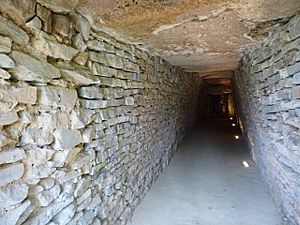Tholos de El Romeral facts for kids
Quick facts for kids Tholos de El Romeral |
|
|---|---|

Tholos de El Romeral; walls of small rubble, megalithic capstones
|
|
| Official name: Antequera Dolmens Site | |
| Type | Cultural |
| Criteria | i, iii, iv |
| Designated | 2016 (40th session) |
| Reference no. | 1501-002 |
| Region | Europe and North America |
Tholos de El Romeral is an ancient burial site. It's located about 2.5 kilometres (1.6 mi) northeast of Antequera in Andalusia, Spain. This amazing place is a great example of Neolithic architecture. That means it was built a very long time ago, around 1800 BCE. People also call it Cueva de Romeral or Dolmen de Romeral.
It's one of three important ancient tombs in the area. The other two are Dolmen of Menga and Dolmen de Viera. They are both located to the southwest. In 2016, these three dolmens became a UNESCO World Heritage Site. This means they are very special and important to the whole world.
When Was It Built?
For a long time, people thought all three big tombs in the area were built at the same time. These tombs are the Dolmen of Menga, the Dolmen de Viera, and Tholos de El Romeral.
However, new studies show they were built at different times. The Dolmen de Menga and Dolmen de Viera are much older. They were built around 3800 BCE. Tholos de El Romeral was built later, around 1800 BCE.
This later date connects it to the Los Millares culture. This culture was centered over 200 kilometers to the east. The different building materials and chamber shapes helped experts figure this out. The other two tombs have rectangular rooms, but El Romeral has round ones.
How Was It Built?
Tholos de El Romeral is a special kind of tomb. It's a chambered tomb covered by a large mound of earth. It has a long hallway with walls made of small stones. These are called drystone walls because they don't use mortar. The ceiling of the hallway is made of huge stone slabs.
This hallway leads to two round, beehive-shaped rooms. The first room is bigger, about 4.20 metres (13.8 ft) across. Its walls are built in a special way called "corbelling." This means the stones stick out a little more with each layer. They get closer together as they go up, forming a dome shape. A large stone slab covers the very top. The floor of the hallway and the main room are made of packed earth.
The second room is smaller and connected to the first by a short, rectangular passage. Visitors cannot go into this second room. It's about 2 metres (6 ft 7 in) wide. Inside, there's a stone slab that might have been used as a bed for the dead. The floor of this small room is also covered with stone slabs.
When the dolmen was explored, archaeologists found human bones inside. They also found seashells and two types of ancient pottery. This proves that Tholos de El Romeral was definitely used as a burial site.
Gallery
See also
 In Spanish: Tholos de El Romeral para niños
In Spanish: Tholos de El Romeral para niños
- Megalithic Monuments of Alcalar
- Dolmen de la Pastora
- Tholos do Barro
- Dolmen of Montelirio
- Valencina de la Concepción
- Prehistoric Iberia
- Bell Beaker culture
- Treasury of Atreus







